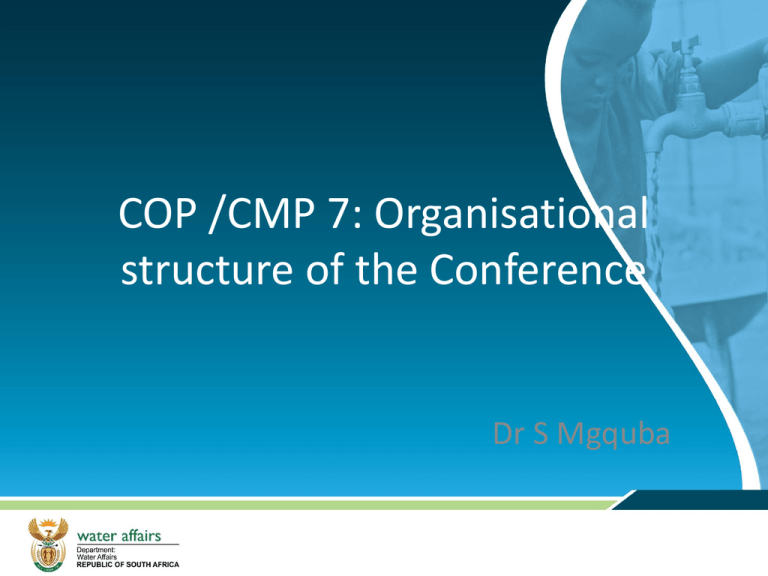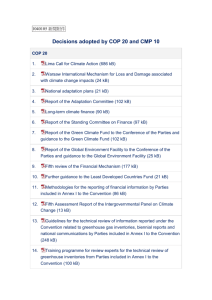COP /CMP 7: Organisational structure of the Conference
advertisement

COP /CMP 7: Organisational structure of the Conference Dr S Mgquba Structure of the presentation • • • • • • History The UNFCCC The KP Convention Bodies Principles of the Convention Groupings of the Convention History of the COPs • • • • Rio 1992, WSSD 1: Three conventions are adopted The CCD (Desertification) The UNFCCC (Climate Change) The CBD (Biological Diversity) • Objective of the UNFCCC “stabilisation of greenhouse gas concentration in the atmosphere at a level that would prevent dangerous anthropogenic interference with the climate system. Such a level should be achieved within a time frame that allows ecosystems to adapt naturally to climate change, to ensure that food production is not threatened and to enable economic development to proceed in a sustainable manner”. THE UNFCCC COPS Where Major decisions COP1, 1995 COP2, 1996 Berlin, Germany The Berlin Mandate Geneva, Switzerland COP3, 1997 COP4, 1998 COP5, 1999 Kyoto, Japan The Geneva Declaration The Kyoto Protocol Buenos Aires, Argentina The Buenos Aires Plan of Action Bonn, Germany COP6, 2000 The Hague, Netherlands COP7, 2001 Marrakesh, Morocco COP8, 2002 COP9, 2003 New Delhi, India The Bonn Agreements (incomplete) The Bonn Agreements (completed). The Marrakesh Accords (incomplete) The Delhi Declaration (SD) Milan, Italy ??????????????????? COP10, 2004 Buenos Aires, Argentina Marrakesh Accords Ministerial UNFCCC........ cont COP WHERE Outcomes CMP1, 2005 Montreal, Canada CMP2, 2006 Nairobi, Kenya CMP3, 2007 Bali, Indonesia CMP4, 2008 Poznan, Poland The MOP sits for the first time...CMP decisions Review of the Financial Mechanisms Bali Road Map (AWG–LCA is mandated ) Advancing the Bali Road Map CMP5, 2009 Copenhagen, Denmark The Copenhagen Accord CMP6, 2010 Cancun, Mexico The Cancun Agreements CMP7, 2011 Durban, South Africa ??????????????????? The Kyoto Protocol • COP 1 decided that the commitments in terms of the UNFCCC were inadequate and • Mandated the initiation of a process to negotiate a protocol or other legal instrument containing commitments for Annex 1 countries • This process culminated in the adoption of the Kyoto Protocol at COP 3 (1997) of the UNFCCC in Japan • The Protocol is therefore primarily concerned with addressing the commitments of Annex 1 Parties, • Through the imposition of targets and mechanisms and/ or obligations for achieving these targets (such as policies and measures and flexible mechanisms). Bodies of the conv. • • • • • • The Conference of the Parties (COP): the “supreme body” of the Convention, that is, its highest decision-making authority. The meeting of the Parties (CMP): the Conference of the Parties serves as the meeting of the Parties to the Kyoto Protocol (CMP). The CMP meets during the same period as the COP. Subsidiary Body for Scientific and Technological Advice (SBSTA) and the SBSTA’s task is to provide the COP with advice on scientific, technological and methodological matters. The Subsidiary Body for Implementation (SBI). These bodies give advice to the COP and each has a specific mandate. The SBI gives advice to the COP on all matters concerning the implementation of the Convention. Ad-hoc Working Group on further commitments for Annex I Parties under the Kyoto Protocol (AWG-KP): Parties to the Kyoto Protocol initiated a process to consider further commitments by Annex I Parties for the period beyond 2012. Ad-hoc Working Group on Long-term Cooperative Action under the Convention (AWG-LCA): Road Map which consists of a number of forward-looking decisions that represent the various tracks that are essential to strengthening international action on climate change. Bodies of the conv. CMP 7 • • • • • • COP 17 Highest bodies, Once a year MOP 7 SBI 35 Twice a year SBSTA 35 AWG-KP 16-4 4 times a year AWG-LCA 14-4 How do these bodies function • • • • Obligations of the Parties and Principles of the Convention The primary means of addressing these principles is the division of countries into two broad groups under the Kyoto Protocol: those listed in Annex I (“Annex I Parties”) which are mainly developed countries and major polluters and those not listed in Annex I (referred to as “non-Annex I Parties”) which are primarily developing countries. • Article 4 of the Conv: contains the commitments which apply to all Parties. The list of commitments is qualified by the chapeau that states that Parties must take into account • “their common but differentiated responsibilities and respective capabilities and their specific national and regional developmental priorities, objectives and circumstances.” In terms of Article 4 all countries that have ratified the UNFCCC are required to: • • • • • • • • • • • • develop, update and publish national inventories of anthropogenic emissions by sources and removals by sinks of greenhouse gases (except those listed in the Montreal Protocol); formulate, implement and update national and regional programmes containing measures to mitigate climate change; promote and co-operate in the development and transfer of technology that controls, reduces or prevents anthropogenic emissions of greenhouse gases; promote sustainable management, conservation and enhancement of sinks and reservoirs of greenhouse gases; co-operate in preparing for the adaptation to the impacts of climate change; take climate change considerations into account where feasible, in relevant social, economic and environmental policies and actions with a view to minimizing adverse effects on the economy, public health and the quality of the environment; promote and co-operate in research; promote and co-operate in the timeous and transparent exchange of information, including scientific technological and socio economic and legal information; promote and co-operate in education, training and public awareness and to encourage the widest participation in this process; and report to the Conference of the Parties (COP). Country divisions • • • There are 198 countries under the Convention and 194 under the Protocol These countries are further grouped into A1 and NA1, which are further grouped into categories either by location, economic standing. The biggest current issue that is a “bone of contention” in climate negotiations is the “developing economies” Annex 1 Countries Other Groupings that influence UNFCCC discussions Annex 2 Non- Annex 1 (G77&China) currently 138 countries AFRICA (Regional groups, e.g. SADC) UMBRELLA G20 OPEC G8 OECD LDCs (Asia, Afr, Latin America) EU G8 + 5 SIDS / OASIS JUSCANZ G4 (IBSA, BASIC, ) South Africa’s positioning with the climate multilateral regime • Africa Group………might be some “tensions”, RSA not trusted . • G4……….strong economy interests, specially the closing the gap with the Chinese • LDC group……RSA not allowed • G8, EU, JUSCANZ – only bilateral cooperation. • OPEC……Not very good ‘friends’ especially Nigeria • OECD……… allowed at observer level.











